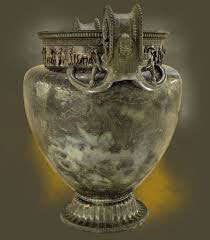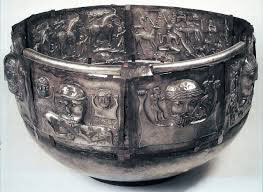
Vix crater: a large bronze jar for mixing wine made in Greece and found in a rich woman’s tomb in central France (ca. 500 BC) – Iron Age Europe
Settlers arrive from other places
About 1000 BC, Greek and Phoenician colonists were settling all around the Mediterranean Sea, and bringing more and more West Asian and Greek culture to Northern Europe.
Bronze Age Northern Europe
Archaic Greek economy
Who are the Phoenicians?
All our Northern Europe articles
What were Europeans trading?
Northern Europeans traded tin and furs, wood, salt, sausages, and slaves for wine, olive oil, Greek pottery, glass beads, linen cloth, African ivory, and iron knives and swords.
History of iron
Where does salt come from?
History of pigs and pork
Black figure pottery
History of slavery
Hallstatt culture
The chiefs used these luxuries and the swords to get more and more control over their people. The resulting culture, known as the Hallstatt culture after a salt mining area of Austria that got rich from selling salt, spread all across Europe in the 700s BC.
Hallstatt and the Illyrians

Gundestrup Cauldron (Central Europe, ca. 100 BC)
La Tene culture
Around 500 BC, the Hallstatt Culture was displaced by the La Tene (lah-TEN) culture, centered further north and west in what is now northern Germany.
The Romans conquer Europe
Beginning around 100 BC, the Romans began not just to trade, but to conquer the people of northern Europe.
Who are the Romans?
The Roman army
All our ancient Rome articles
By 150 AD, the Roman Empire controlled Britain, France, Belgium, much of Germany, Spain, Portugal, and the Balkans (as well as Greece and Italy). North of the Danube River, most of Central Europe was still independent, but they were more and more influenced by Roman traders and Roman ideas.

Ostrogothic helmet imitating Roman helmets (ca. 400 AD)
Europe becomes Romanized
Many Northern European men, from both sides of the Roman border, fought in the Roman army. Many Northern European houses, bridges, and roads were built in the Roman style.
Roman houses
Roman religion
Arian Christianity
Northern European people often wore Roman jewelry, and sometimes wore Roman clothing, and prayed to Roman gods. In the 200s and 300s AD, Roman missionaries converted many people in Northern Europe to Arian Christianity.
The fall of Rome
But the power of Rome was already ending. When the Sassanians began to attack Rome’s eastern border about 220 AD, the Northern Europeans attacked at the same time, and the Romans had to split their army between the two wars.
Who are the Sassanians?
Attila the Hun
The Romans couldn’t afford to keep fighting two wars at the same time, and gradually the Northern Europeans, fighting as soldiers for Rome, noticed that there really wasn’t any strong Roman army anymore. At the same time, a new invasion from Central Asia began: the Huns were sweeping over northern Europe.
The Visigoths
The Vandals
The Franks
And the Ostrogoths
To get away from the Huns, the people of Northern Europe started to move into the Roman Empire. In 376 AD, the Visigoths crossed the Danube river; in 409 AD the Vandals, Alans, and Sueves crossed the Rhine river, and the Franks and Ostrogoths soon followed them.